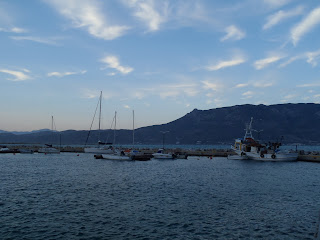Hi guys,
Unless I get inspired to put up more pictures or do some
sort of later retrospective post, this is probably the last entry of Cam and
Laurel Take On the Greece. I’m writing this in JFK airport and on the plane
back to SLC, where I’ll be doing research with a physics professor at the
University of Utah for the summer.
The Lion Gate at Mycenae. It's pretty big.
We spent the last week of the trip, after an off-day in Athens, primarily looking at Mycenaean sites (the mainland Bronze Age culture; named after the palace of Mycenae, the home of Agamemnon in the Iliad and Greek mythology in general). Mycenaean palaces are probably most impressive because of their "Cyclopean" masonry walls, which are made of huge blocks of stone (so big that only a Cyclops, or a big group of really well-organized people, could lift them). They also have really interesting tombs, with the beehive-shaped tholos tombs being the most distinctive. We traveled in the northern Peloponnese, Boetia, and Thessaly to explore Mycenaean and Neolithic sites (including a fun stop on a walk from Mycenae to nearby Berbati to go "sherding" in a local farmer's field, and another stop below a Neolithic cave settlement site to find chipped stone tools...but you didn't hear that from me).
Entrance to the "Treasury of Atreus" (actually the biggest of the tholos tombs, but whatever) at Mycenae. For reference, those blocks in the foreground come up to my upper thigh.
Our last few days were spent in Athens, with a day trip to Marathon, Thorikos (a Mycenaean site, later part of Classical Athens), Laurion (home of the silver mines that made 5th century Athens rich, allowing its transformation into the foremost naval power in Greece), and Sounion (the southernmost tip of the Attic peninsula), and then an off day. I spent my off day on a nice OD run up Mt. Hymettus (on the east side of Athens), sat on the Areopagus (a hill where an important governmental council met in ancient Athens) for a while, visited the Acropolis one last time, and had a huge group dinner at a Brazilian restaurant.
Prof. Rutter at our last site, the Temple of Poseidon at Sounion.
View of Athens from the top of Mt. Hymettus.
One last look at the Parthenon.
I don't feel like rehashing all of my closing statement, which will be found on the official blog shortly, so I'll just say it's been amazing and exhausting to go on this trip, but mostly awesome and wonderful. Every person on the FSP is fascinating and unique, and it was great to get to know all of them a little (or a lot) better. Here's hoping we stay in touch and that some of us, at least, can go back to Greece later in life.
Poda para poda, epite, apite, and safe travels,
Laurel





































.JPG)














